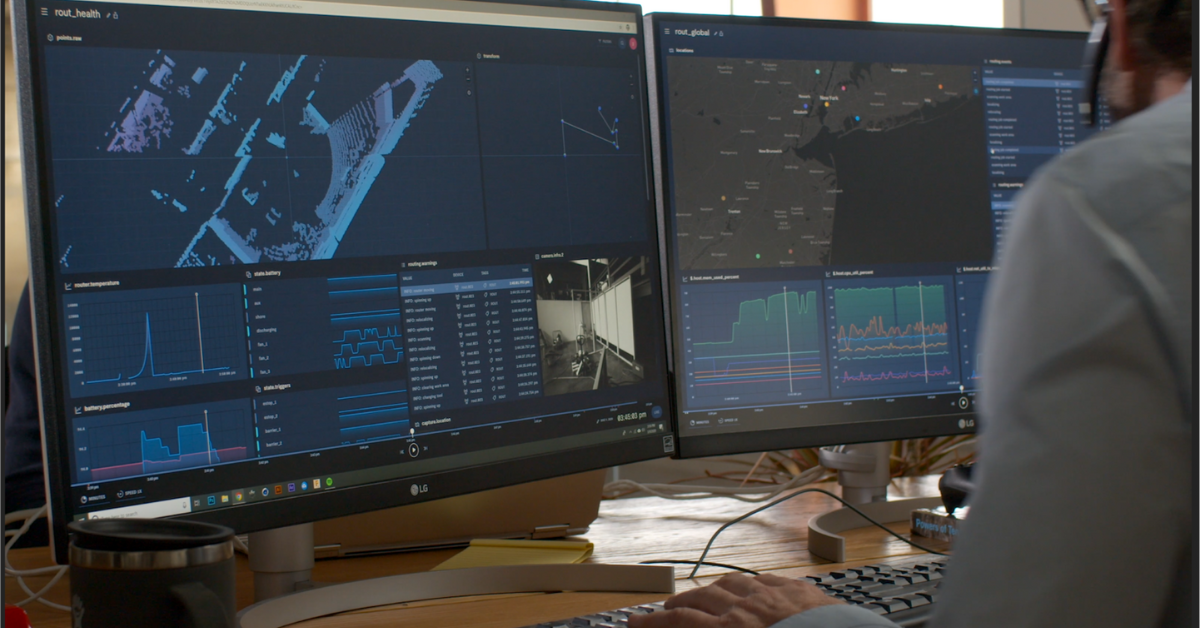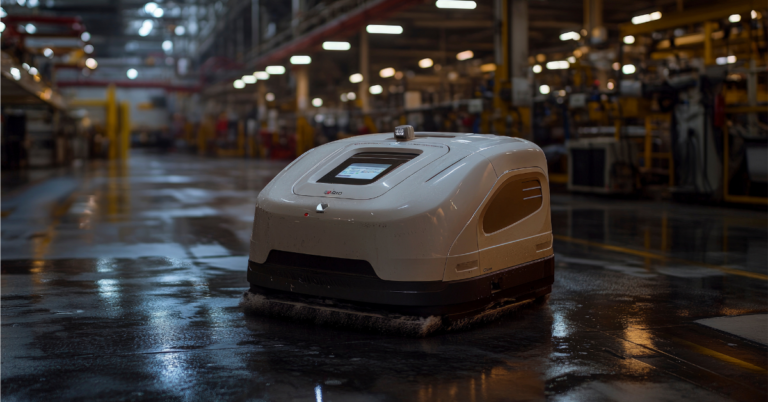Your year is off to a great start; your pilot deployments have gone well, customers are happy, and the demand for your robot is steadily rising. Until now, your robot operations and data ingestion have been managed on your internal platform.
You’ve built your robot platform….
Now comes the maintenance and scaling of it. By now, you’ve likely built out your DevOps and support team, and have your data pipeline set up as well- so what’s next?
There are two ways you could about this.
Let’s keep it.
As your fleets continue to prove to be incredibly successful for customers, the demand for robots is steadily rising. Your DevOps team has grown with a talented group of engineers handling the technical aspects, and your data pipeline is up and running smoothly. But what’s next?
The team decided not to take the risk for fear it could cause delays in onboarding as well as force employees and customers to transition systems over. With growth comes scaling of your internal team to keep up with the demand of rising tech support needs, especially from some of the enterprise customers you’ve recently closed. Some new additions to the team include a few data engineers to assist with the data and tech support to help respond to customer requests. Although the demand for the DevOps and tech support teams is rising, it’s still manageable and only requires a few late nights for the team.
The ability to completely control updates and new features is a reassuring benefit of keeping your platform and enables the team to customize workflows for customers whenever they should need it. The metrics and logging platform built internally worked well when the support team was highly technical, but as we scaled and hired less technical support staff, it was taking them longer than expected. Occasionally, a new feature launch needs to be delayed due to a customer issue or bug, but most timelines are met without too much of a problem. A few high-profile companies have approached you about the security of your platform, and thankfully as it’s all in-house, your company has complete control, reducing the risk of data breaches and maintaining customer trust.
As the company expands into Europe, the added load of deployment and compliance is making the team feel the pressure cooker that can result from scaling. Tech support tickets are beginning to pile up and the delays in uptime and productivity due to issues are having an impact on some customer’s satisfaction. Not to mention, hiring costs are scaling quickly- with each new deal won for the company is another job posting for the DevOps or tech support team to make sure they have the support for a new fleet. Unfortunately, the amount of data being ingested by your platform is also causing bandwidth costs to rapidly increase, threatening to exceed your budget and putting stress on the tech stack, you, and your customers. Your customer churn remains under 5%, but customer engagement seems to be low.
At last, a new round of funding provides some relief! This allows for more hires to join the team and turn customer issues around quicker than ever before. But keep in mind, consistent growth will continue to push the limits of your robot platform and require equal team expansion to match it.
Start looking elsewhere.
Your customer base has grown significantly since your first deployment, and you’re seeing great results of increased productivity across fleets.
Until now, your robot operations and data ingestion have been managed internally. Users appear happy with the interface and quickness of support received from the internal team. However, as you stand at the crossroads of maintenance and scaling, you can’t help but wonder if your platform – and team – can handle managing more customer data without outside help.
A third-party robot platform offers an external team to support your customers, so any data or operations-related issues won’t have as much or any effect on customer uptime. This frees up your team to focus on other projects and provides peace of mind that tech support issues can be resolved quickly. To make the decision, you dive into researching the best third-party solution for your company. You demo a few and eventually land on one that is best aligned with company goals.
The transition to the new platform takes time and bandwidth to migrate their tools, but the onboarding itself only takes a week. Only a month into your new platform and DevOps hiring costs have now slowed as any operations-related issues for customers are outsourced to expert hands. Although you were concerned customer churn would experience a potential increase when switching software, they seem to appreciate the new features that allow them to gain insights on how efficient their service is, increasing engagement with the robot application. Bandwidth costs that used to push your budget are also now easier to manage as you can set limits to how much data is ingested based on customer needs.
Q2 has brought in six new customers and luckily, your third-party platform is ready to scale alongside you- all you need to do is add the device and the new users to the platform and you’re ready to go! Your team’s efficiency to respond to support tickets have gone up 30 percent, reducing the need to scale the tech support team linearly, and your field operations team is not flying onsite to resolve issues as frequently, thus reducing the overall operating costs.
What are some clues to help you in your decision?
Each path has its own pros and cons, but the decision truly comes down to the state of your internal operations and goals.
As mentioned above, deciding to stick with your own platform will eventually present its own challenges during scaling- from expanding bandwidth to hiring new roles, increased costs will reflect any growth. However, it is important to acknowledge that this will vary from company to company and there are variables that may not make scaling as daunting of a challenge internally. These costs should be tracked by your team so you can make the best decision and determine when you may need to consider switching to a third-party platform, if ever.
For many robotics companies, there are red flags that can signal the management of your platform is outpacing your team.
Tech support overload
Someone once said “more money, more problems”, and this couldn’t be truer as you scale. More customers means more data ingestion and the potential for issues to occur. If the support team has to grow linearly with the number of customers added, it’s time to seek a third-party option to help resolve customer issues faster.
Customer engagement is low
No one likes losing customers, especially if you’ve already spent more money scaling internal teams to have supported them. Not all customer churn is a signal that you should replace your robot platform, but if it’s attributed to data issues or delays in team response, you can likely guess your team is becoming overloaded. It might be an overwhelming thought to move your tools and customer operations to a new platform, but having backup support is well worth the migration.
Struggling to gain customer insight
Not knowing how your customers use their robots is another issue that could spell trouble. When deploying robots, it’s essential to have a pulse on whether the fleet is fulfilling their purpose and making a business case. If your robot platform isn’t monitoring your devices properly, customer churn can quickly increase. Most third-party platforms provide reliable monitoring of devices so you can have confidence that your robots are operating as they should, keeping customers happy and new business streaming in.
Operational costs are growing faster than new customers
Operational costs span from bandwidth to support costs associated with expanding your customers and thus, your support team. Data is precious and is instrumental for many activities from debugging to seeing fleet-wide trends and revealing the ROI of your robots. From just one robot can come a multitude of data, and the cost to ingest it quickly scales as your customer base does. If you’re not prioritizing data either, this can also send bandwidth costs skyrocketing which will creep up spending for your customers, as well. A third-party robot platform can help to prioritize your data, visualize it any way you need, and set spending caps on bandwidth costs. Additional operational costs can include on-site visits needed for support or customer relationship-building purposes.
Team burnout
We mentioned team burnout in the option to keep your platform, and this is one of the biggest red flags that can signal you need to explore other options. Even a well-rested and motivated DevOps team will have trouble keeping up with a backup of tech support tickets, but a burnt-out team could spell major trouble for customers and churn. Burnout is also troublesome for team morale- taking care of burnout helps to maintain a happy and productive team.
Align your platform with future goals
We all hope for growth and more customers but keep in mind that this means more of a tech support and cost burden on your team. These costs may seem to plateau at times, but they’ll never stop rising as long as your users do.
It’s vital to make the switch at the right time (if you decide to) and wait until you feel absolutely sure it’s the right fit for your company. Check into your options to see who aligns most with your goals for scaling, and even reach out to your team for their opinion on what they’d like to see from a third-party data platform. They have the most unique insights from customers as to what is needed to support various fleets.
When searching for a third-party platform, be sure to look into Formant. As the data platform for robotics companies, we’re passionate about helping robotics companies scale sustainably. we have experience supporting fleets of all sizes across industries including agriculture, property management, warehousing and logistics, and more.
If you’re pondering whether to keep or replace your robot platform, our team would be happy to talk over your decision with you in a no-pressure environment. We have experience migrating many customers from their internal platforms and understand it’s a huge decision for your company. Let us help you understand your options- even if that means it might not be the right time yet. If this sounds helpful, you can request a demo with our team.



